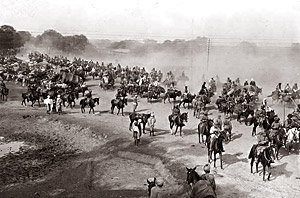 Titumir or Titu Mir was a rebel against the zamindars of the British colonial system in 19th century Bengal that was an integral part of British India. He rebelled against the rich landlords and colonial British rulers and effectively put up a remarkable resistance. Titumir built a Bamboo fort (Bansher-Kella in Bangla) along with his followers
Titumir or Titu Mir was a rebel against the zamindars of the British colonial system in 19th century Bengal that was an integral part of British India. He rebelled against the rich landlords and colonial British rulers and effectively put up a remarkable resistance. Titumir built a Bamboo fort (Bansher-Kella in Bangla) along with his followers
Titumir was born as Sayyid Mir Nisar Ali in 27 January 1782 in a small village named Chandpur, in the Basirhat Thana area of the North 24 Parganas district. Titumir`s father was Mir Hassan Ali and his mother was Abeeda Rukaya Khatun. Titumir`s education started in his village school, after which he was admitted to a local Madrassa that is a traditional Muslim school. When, he was 18 years of age, Titumir had become a Hafiz of the Qur`an, which means that he memorized the Qur`an by heart and thus became a scholar of the Hadith or Muslim traditions. Titumir was also well learnt in Bengali, Arabic, and Persian. During this time he came under the authority of several Wahabi prophets, who preached a blend of militant Islam and anti-colonial thought and thus introduced both religious and political reform that was extremely necessary in Bengal of that time.
In 1822, Titumir went on a pilgrimage to Mecca, the Haj and joined all Muslims. There, he came in close contact with the great Islamic reformer and revolutionary leader Sayyid Ahmad of Bareilly who inspired him to free his fellow countrymen from un-Islamic practices and foreign authority. On his return from Makka in 1827 Titumir started preaching among the Muslims in the districts of 24 Parganas and Nadia. He advised them to abstain from practicing shirk and bidaat and inspired them, especially the weavers class and peasants, to follow the Islamic way of life.
In the process, Titumir came into conflict with the Hindu zamindar Krishnadeva Rai of Purha for his sectarian approach towards the Muslims and commanding illegal taxes on them. Titumir happened to be in conflict with other landlords like Rajnarayan of Taragonia, Kaliprasanna Mukhopadhyay of Gobardanga, Gauri Prasad Chowdhury of Nagpur and Devanath Rai of Gobra-govindpur for their cruelty on the peasantry. Titumir wore the `tahband` a tube shaped garment worn around the waist and not the traditional the dhoti and his followers put on the same garment likewise.
 Titumir opposed a number of discriminatory measures vigorously of that time which included taxes on the shaving of beards and on mosques. The rift between Titumir and his followers on one side, and the local Zamindars were however supported by the British rulers on the other side, continued to get wider and armed conflict broke out at many places. Titumir himself served a Zamindar as a `lathial or `lethel` a fighter with the quarterstaff. This quarter in Bengal was made of bamboo, not wood and he was actively training his followers in hand-to-hand fight and the use of the bamboo staff. This weapon of bamboo in skilled hands can be proved to be deadly against anything except projectile weapons.
Titumir opposed a number of discriminatory measures vigorously of that time which included taxes on the shaving of beards and on mosques. The rift between Titumir and his followers on one side, and the local Zamindars were however supported by the British rulers on the other side, continued to get wider and armed conflict broke out at many places. Titumir himself served a Zamindar as a `lathial or `lethel` a fighter with the quarterstaff. This quarter in Bengal was made of bamboo, not wood and he was actively training his followers in hand-to-hand fight and the use of the bamboo staff. This weapon of bamboo in skilled hands can be proved to be deadly against anything except projectile weapons.
The followers of Titumir, believed to have grown to 5,000 by that time and they were ready for a prolonged armed conflict. They built their fort of bamboo at Narikelbaria, near the town of Barasat and that was surrounded by a high double curtain wall of bamboo stakes filled in with mud shell and sun-baked. Titu Mir stated independence from the British, and regions including the present districts of 24 Parganas, Nadia and Faridpur came under his control. The private armies of the Zamindars and the forces of the British confronted a series of defeats at the hands of his men as a result of his strike-and-retreat guerrilla process.
Finally, the British forces, which came armed with cannon and muskets concentrated on vigorous attacks on 14 November 1831. The attacks were especially on Titumir and his followers. With their simple swords and spears made of bamboo, they could not withstand the might of modern weapons used by the opposition forces. The bamboo castle was destroyed, and Titumir was killed along with several of his followers. The commanding officer of the British forces noticed his opponent`s bravery in dispatches, and also commented on the strength and hardiness of bamboo as a material for fortification, since he had had to destroy it with artillery after struggling for a long time before it gave way.
The saga of the brave Titumir and the bamboo castle continue to be a source of inspiration in West Bengal. The story is also believed to have enthused the freedom fighters of Bangladesh in the liberation war of 1971. Mahasweta Devi wrote a novella titled Titumir, and Titumir-er Basher Kella that has been a popular play on TV in Bangladesh as well. It has also featured as a theme for Puja pandals, often done up as historical tableaux.



















